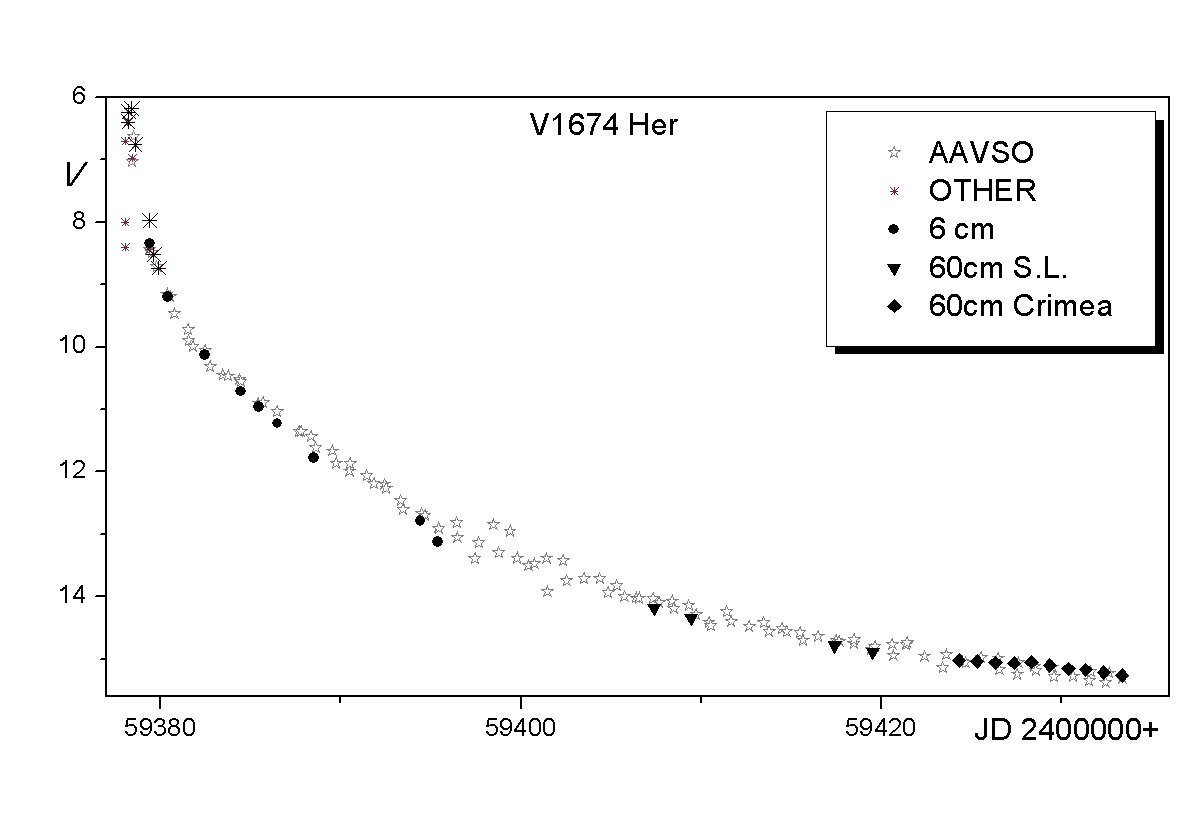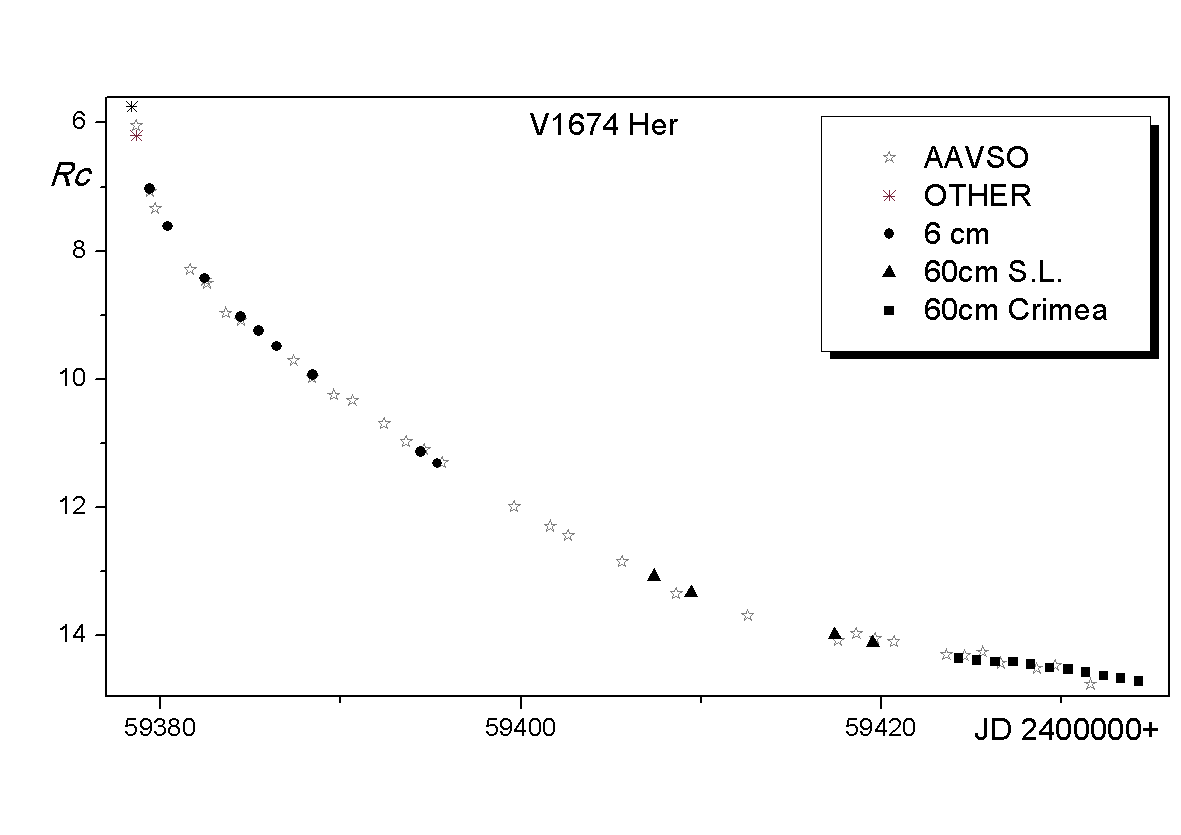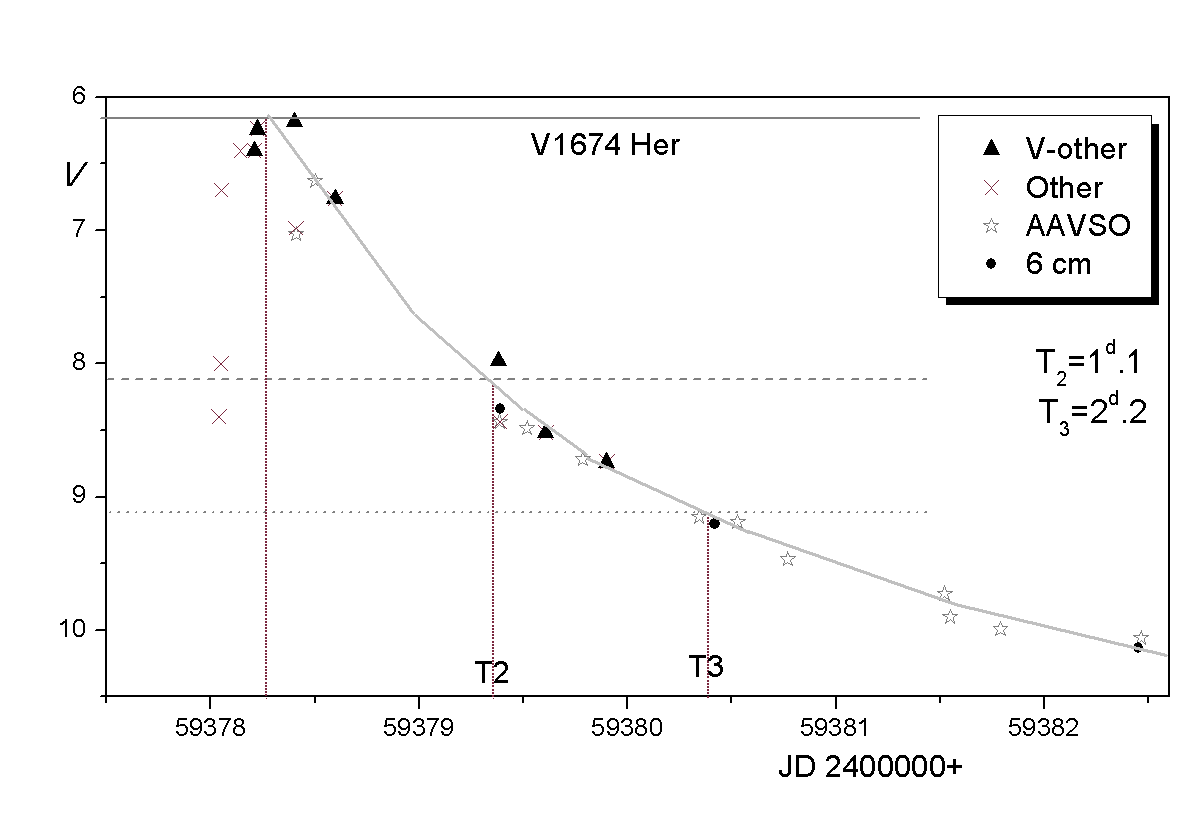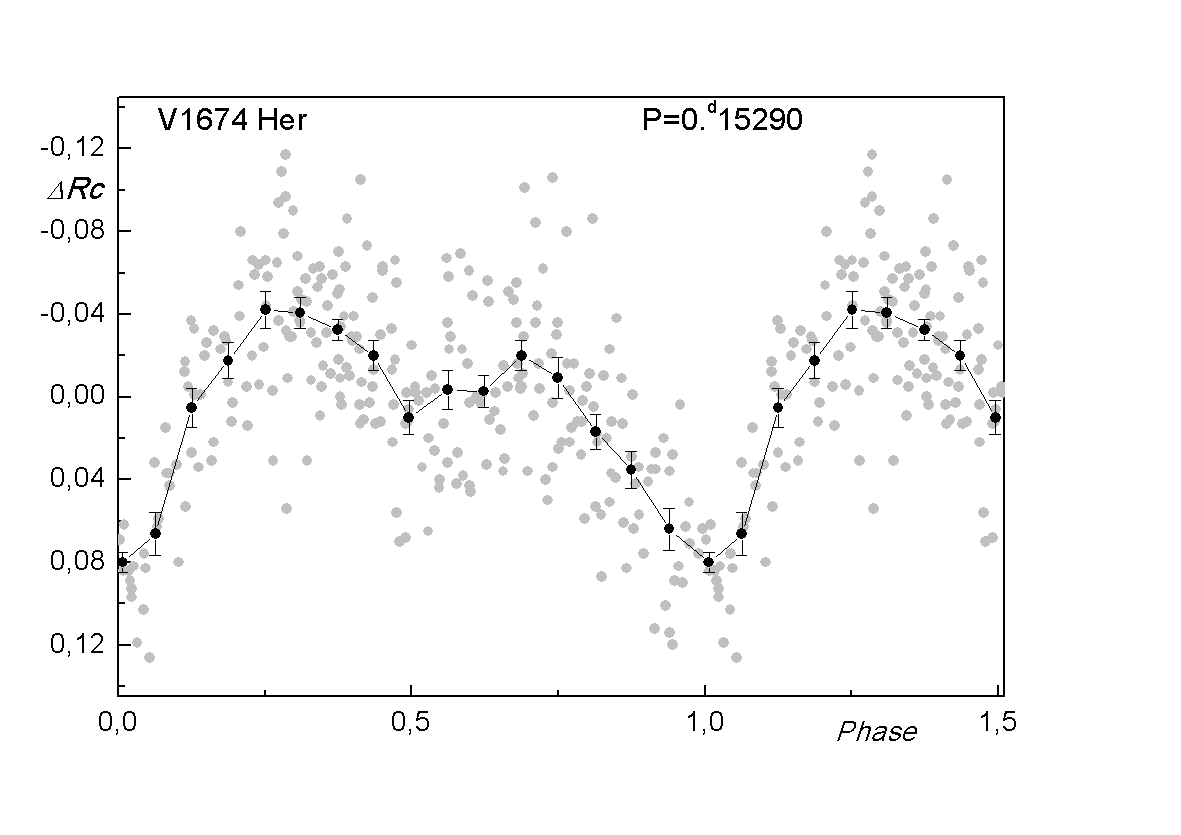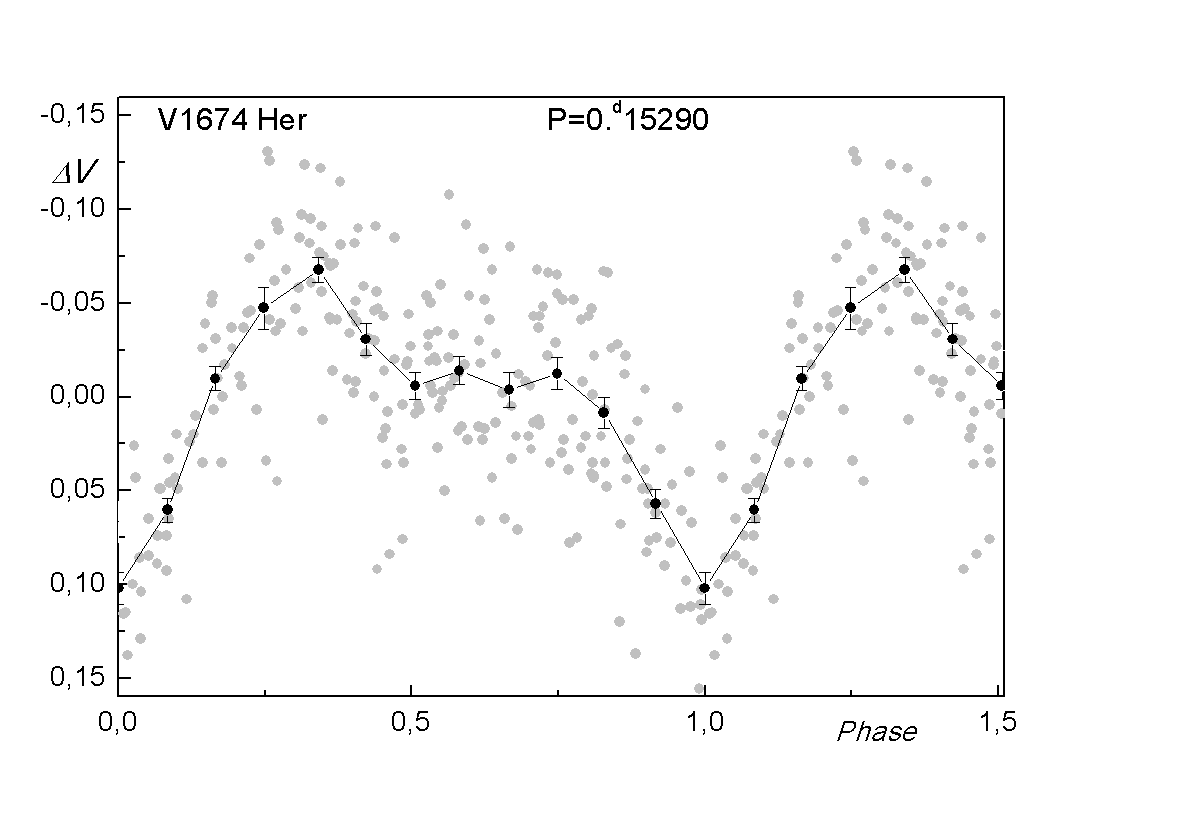|
Peremennye Zvezdy (Variable Stars) 41, No. 4, 2021 Received 12 July; accepted 10 August. |
Article in PDF |
|
DOI: 10.24412/2221-0474-2021-41-14-18
|
PHOTOMETRIC STUDY OF CLASSICAL NOVA V1674 Her
S.Yu. Shugarov1,2, M.D. Afonina2,3
- Astronomical Institute of Slovak Academy of Sciences, Tatranska Lomnica,
05960, Slovakia
- Sternberg Astronomical Institute, Moscow University,
Universitetsky avenue 13, Moscow, 119992 Russia
- Lomonosov Moscow University, Faculty of Physics, Leninskie Gory 1, Moscow, 119991 Russia
|
An analysis of the new |
1. Introduction
The variable star TCP J18573095+1653396 = V1674 Her (Kazarovets et
al., 2021) was discovered on 2021 June 12.537 UT as an
![]() star by Ueda et al (2021). The star's light curve is shown in
Fig. 1.
star by Ueda et al (2021). The star's light curve is shown in
Fig. 1.
The spectrum is generally blue and shows broad absorptions (FWHM
about 3000 km/s) compatible with P-Cyg profiles of Balmer, He I,
Fe II, and other lines. The reddening was determined as
![]() (Munari et al., 2021; Aydi et al., 2021; Kuin
et al., 2021; Wang et al., 2021) Using the Fermi-LAT data for
0.1-300 GeV taken on 2021/6/12, an uncatalogued gamma-ray source
was found at the Nova's position (Li, 2021; Sokolovsky et al.,
2021)
(Munari et al., 2021; Aydi et al., 2021; Kuin
et al., 2021; Wang et al., 2021) Using the Fermi-LAT data for
0.1-300 GeV taken on 2021/6/12, an uncatalogued gamma-ray source
was found at the Nova's position (Li, 2021; Sokolovsky et al.,
2021)
According to Mroz et al. (2021), our object had a short period of
![]() (8.357 min), which is presumably a spin period of
the white dwarf, and the system is an intermediate polar. The
lines of [Ne III], [Ne IV] were also found in the spectrum. The
presence of these strong neon emission lines is likely
attributable to overabundances of neon, showing that V1674 Her is
a member of the class of neon Novae, such as QU Vul, V838 Her,
V1974 Cyg, etc. (Wagner et al., 2021; Ochner et al., 2021). The
observation on July 1 showed that the super-soft source phase of
V1674 Her had begun (Page et al., 2021). According to Patrick
Schmeer (see Ueda et al., 2021), the likely progenitor is a
(8.357 min), which is presumably a spin period of
the white dwarf, and the system is an intermediate polar. The
lines of [Ne III], [Ne IV] were also found in the spectrum. The
presence of these strong neon emission lines is likely
attributable to overabundances of neon, showing that V1674 Her is
a member of the class of neon Novae, such as QU Vul, V838 Her,
V1974 Cyg, etc. (Wagner et al., 2021; Ochner et al., 2021). The
observation on July 1 showed that the super-soft source phase of
V1674 Her had begun (Page et al., 2021). According to Patrick
Schmeer (see Ueda et al., 2021), the likely progenitor is a ![]() star.
star.
2. Observations
After the announcement of the Nova's discovery, we commenced
multicolor photometry of the object. From June 13 to June 29,
![]() observations were carried out using a 60/180 mm
photographic lens and SBIG-ST10XME CCD camera. Between July 11 and
23, a 600/7500 mm telescope and FLI ML3041 CCD camera in
observations were carried out using a 60/180 mm
photographic lens and SBIG-ST10XME CCD camera. Between July 11 and
23, a 600/7500 mm telescope and FLI ML3041 CCD camera in
![]() photometric bands were used. Observation were
performed at the Astronomical Institute of the Slovak Academy of
Sciences in Stara Lesna. From July 28 to August 7,
photometric bands were used. Observation were
performed at the Astronomical Institute of the Slovak Academy of
Sciences in Stara Lesna. From July 28 to August 7, ![]() monitoring was carried out at the Crimean Laboratory of the
Sternberg Astronomical Institute using a 600/7500 mm telescope and
FLI-39000 CCD camera. Seven stars around the variable were used as
reference stars. The magnitudes of these stars were determined by
referencing them to the secondary photometric standard around
YY Her (Henden & Munari, 2021), and also corrected using data
taken from the AAVSO catalog for standard stars around the same
variable. As a result, a star with coordinates RA =
monitoring was carried out at the Crimean Laboratory of the
Sternberg Astronomical Institute using a 600/7500 mm telescope and
FLI-39000 CCD camera. Seven stars around the variable were used as
reference stars. The magnitudes of these stars were determined by
referencing them to the secondary photometric standard around
YY Her (Henden & Munari, 2021), and also corrected using data
taken from the AAVSO catalog for standard stars around the same
variable. As a result, a star with coordinates RA =
![]() , Dec =
, Dec =
![]() (J2000), its
magnitudes being
(J2000), its
magnitudes being
![]() ,
,
![]() ,
,
![]() ,
,
![]() was used as the main standard star for frames
taken with the 6 cm photographic lens. For the 60-cm telescopes, a
star with coordinates RA=
was used as the main standard star for frames
taken with the 6 cm photographic lens. For the 60-cm telescopes, a
star with coordinates RA=
![]() , Dec =
, Dec =
![]() (J2000) having
(J2000) having
![]() ,
,
![]() ,
,
![]() ,
,
![]() ,
,
![]() was the main standard
star.
was the main standard
star.
3. Description and Preliminary Analysis of the Light Curves
The light curves for our time interval are shown in Fig. 1 (![]() band) and in Fig. 2 (
band) and in Fig. 2 (![]() band). To these figures, we also added
observations from the AAVSO and observations by other authors
published in various sources. A rapid fading from
band). To these figures, we also added
observations from the AAVSO and observations by other authors
published in various sources. A rapid fading from
![]() to
to
![]() is seen. The total outburst amplitude is about
is seen. The total outburst amplitude is about
![]() .
Note that the largest outburst amplitude among classical Novae was
detected for V1500 Cyg and amounted to
.
Note that the largest outburst amplitude among classical Novae was
detected for V1500 Cyg and amounted to
![]() (Honda et al.,
1975; Harevich et al., 1975; Young et al., 1976).
(Honda et al.,
1975; Harevich et al., 1975; Young et al., 1976).
Figure 3 shows the light curve for the first 4 days after the
outburst on a large scale. This graph permits us to estimate the
time of brightness decline by ![]() and by
and by ![]() after the light
maximum. According to our estimates, they are
after the light
maximum. According to our estimates, they are
![]() ,
,
![]() . The fastest classical Novae known so far are
V838 Her, V4160 Sgr and V1500 Cyg; for them,
. The fastest classical Novae known so far are
V838 Her, V4160 Sgr and V1500 Cyg; for them,
![]() ,
,
![]() , and
, and
![]() ;
;
![]() ,
,
![]() , and
, and
![]() respectively (Strope et al., 2010; Young et al., 1976). Thus,
V1674 Her is the fastest known Nova star (Wagner et al., 2021).
respectively (Strope et al., 2010; Young et al., 1976). Thus,
V1674 Her is the fastest known Nova star (Wagner et al., 2021).
We carried out multicolor monitoring of the object during days
39-56 (JD 2459417-434) after the outburst maximum. Optical
![]() modulation with a period of
modulation with a period of
![]() was found.
The profile of the light curve has an amplitude close to
was found.
The profile of the light curve has an amplitude close to
![]() and shows two unequal minima separated by half a period. We assume
that this period can correspond to orbital motion in the close
binary system V1674 Her. The light curve folded with the ephemeris
and shows two unequal minima separated by half a period. We assume
that this period can correspond to orbital motion in the close
binary system V1674 Her. The light curve folded with the ephemeris
![]() is presented in Fig. 4 and Fig. 5 (see also Shugarov and
Afonina, 2021).
is presented in Fig. 4 and Fig. 5 (see also Shugarov and
Afonina, 2021).
4. Conclusions
V1674 Her is a very important object for future studies. According
to our data, the object has the steepest brightness-decline
gradient among all known Classical Novae (
![]() ;
;
![]() ). Likely, it is an intermediate polar with a white-dwarf
rotation period of
). Likely, it is an intermediate polar with a white-dwarf
rotation period of
![]() , orbital period
, orbital period
![]() .
Also, it is a member of the neon Novae class, has a large outburst
amplitude, reaching
.
Also, it is a member of the neon Novae class, has a large outburst
amplitude, reaching
![]() ; it is a gamma-ray source and an SSS
source. Therefore, further comprehensive observations of this star
are very relevant.
; it is a gamma-ray source and an SSS
source. Therefore, further comprehensive observations of this star
are very relevant.
Acknowledgments
This work was supported by grants from the Slovak Academy VEGA
2/0030/21, APVV-20-0148; from M.V. Lomonosov Moscow State
University Program "Leading scientific schools" (the project
"Physics of stars, relativistic objects and galaxies").
References:
Aydi, E., Sokolovsky, K.V., Chomiuk, L., et al. 2021, Astronomer's Telegram, No. 14710
Harevich, V., Bocharov, A.N., Shugarov, S.Yu., et al. 1975, IAU Circulars, No 2839
Henden, A. and Munari, U. 2001, Astron. & Astrophys., 372, 141
Honda, M., Hosawa, K., Osada, K., et al. 1975, IAU Circulars, No. 2826
Kazarovets, E., et al. 2021, CBET No. 4977
Kuin, P., Starrfield, S., Orio, M., et al. 2021, Astronomer's Telegram No. 14736
Li, K.-L. 2021, Astronomer's Telegram No. 14705
Mroz, P., Burdge, K., van Roestel, J., et al. 2021, Astronomer's Telegram No. 14720
Munari, U., Valisa, P. and Dallaporta S. 2021, Astronomer's Telegram No. 14704
Ochner, P., Andreoli, V., Farina, A., and Reguitti, A. 2021, Astronomer's Telegram No. 14805
Page, K.L., Orio, M., Sokolovsky, K.V., and Kuin, N.P.M., 2021, Astronomer's Telegram No. 14747
Shugarov, S. and Afonina, M. 2021, Astronomer's Telegram No. 14835
Sokolovsky, K., Aydi, E., Chomiuk, L., et al. 2021, Astronomer's Telegram No. 14731
Strope, R.J., Schaefer, B.E., Henden, A.A. 2010, Astron. J., 140, 34
Ueda, S., Hokkaido, K., Pearce, A., et al. 2021:
http://www.cbat.eps.harvard.edu/unconf/followups/J18573095+1653396.html
Wagner, R.M., Woodward, C.E., Starrfield, S. 2021, Astronomer's Telegram No. 14746
Wang, J., Gao, C., Xin, L.P., et al. 2021, Astronomer's Telegram No. 1473
Young, P.J., Corwin, H.G., Bryan, J.R., and de Vaucouleurs, G., 1976, Astrophys. J., 209, 992
